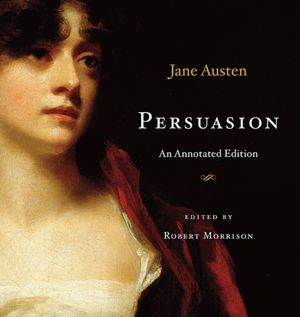Persuasion: An Annotated Edition, edited by Robert Morrison
Feb 15
2012

Before I get started, let me clarify something: this isn't a review of Jane Austen's Persuasion. It's more an extended hissyfit about the annotations featured in this particular edition of Persuasion, and therefore I'm going to assume it's only going to interest my fellow hardcore Austen nerds. (Sorry, non-hardcore-Austen-nerds. Try again tomorrow.) Anyway: VAGUE SPOILERS AHOY.
I received this edition of Persuasion for my birthday, and—seeing as I'd suggested it to practically everyone I know as my ideal potential present—I was totally stoked about it. I read all of the annotations first, independent of the text, and then went back and re-read the book, finding at least 80% of editor Robert Morrison's notes both relevant and interesting.
Unfortunately, that left the remaining 20%, which ranged from immaterial to incorrect to simply baffling. Examples include, but were not limited to:
IMMATERIAL STUFF: Morrison's fondness for defining common Regency-era words: "'Consequence' is 'social status'"; "'Intelligence' is 'news' or 'information'", etc. I suspect most people willing to shell out $35 for an annotated edition of one of Austen's less popular books are already familiar with these terms.
INCORRECT STUFF: I really started to worry when Morrison defined "to be vain of" (used in Vol. II, Ch. 3 to describe Sir Walter, who found "much to be vain of" despite the "littleness" of Bath) as "to disregard, to treat with contempt". Uh... I'm pretty sure it means "to be vain about", at least in this context.
SIMPLY BAFFLING STUFF: There was a lengthy explanation of a minor change Morrison made to the text (replacing she with he in the line "she was at this present time... wearing black ribbons for his wife"). The original line refers to Elizabeth, Anne's older sister, wearing mourning for her cousin Mr. Elliot's recently deceased wife. Morrison's change switches the focus to Elliot himself, arguing that Elizabeth disapproved of the marriage in question, and therefore wouldn't be wearing black. Now, I'm no expert on early-19th-century social mores, but the Jane Austen Centre points out that "a show of respect was expected even for distant relatives". Wearing mourning for a relation (even despised one) was customary, particularly for upper-class women like Elizabeth. Sincerity was not required. Why on earth would Morrison tweak a nearly 200-year-old text in order to "correct" a phrase that is equally plausible in its original published state?
Don't get me wrong: I'm still really happy Nathan paid attention to my subtle-like-a-brick hints and gave me this book for my birthday. It's a handsomely illustrated and beautifully bound edition, and I learned quite a bit from it. But I can't help but wish the annotations featured in this book had been blessed with a red-pen-wielding editor of their very own.
I received this edition of Persuasion for my birthday, and—seeing as I'd suggested it to practically everyone I know as my ideal potential present—I was totally stoked about it. I read all of the annotations first, independent of the text, and then went back and re-read the book, finding at least 80% of editor Robert Morrison's notes both relevant and interesting.
Unfortunately, that left the remaining 20%, which ranged from immaterial to incorrect to simply baffling. Examples include, but were not limited to:
IMMATERIAL STUFF: Morrison's fondness for defining common Regency-era words: "'Consequence' is 'social status'"; "'Intelligence' is 'news' or 'information'", etc. I suspect most people willing to shell out $35 for an annotated edition of one of Austen's less popular books are already familiar with these terms.
INCORRECT STUFF: I really started to worry when Morrison defined "to be vain of" (used in Vol. II, Ch. 3 to describe Sir Walter, who found "much to be vain of" despite the "littleness" of Bath) as "to disregard, to treat with contempt". Uh... I'm pretty sure it means "to be vain about", at least in this context.
SIMPLY BAFFLING STUFF: There was a lengthy explanation of a minor change Morrison made to the text (replacing she with he in the line "she was at this present time... wearing black ribbons for his wife"). The original line refers to Elizabeth, Anne's older sister, wearing mourning for her cousin Mr. Elliot's recently deceased wife. Morrison's change switches the focus to Elliot himself, arguing that Elizabeth disapproved of the marriage in question, and therefore wouldn't be wearing black. Now, I'm no expert on early-19th-century social mores, but the Jane Austen Centre points out that "a show of respect was expected even for distant relatives". Wearing mourning for a relation (even despised one) was customary, particularly for upper-class women like Elizabeth. Sincerity was not required. Why on earth would Morrison tweak a nearly 200-year-old text in order to "correct" a phrase that is equally plausible in its original published state?
Don't get me wrong: I'm still really happy Nathan paid attention to my subtle-like-a-brick hints and gave me this book for my birthday. It's a handsomely illustrated and beautifully bound edition, and I learned quite a bit from it. But I can't help but wish the annotations featured in this book had been blessed with a red-pen-wielding editor of their very own.
Posted by: Julianka
No new comments are allowed on this post.
Comments
No comments yet. Be the first!